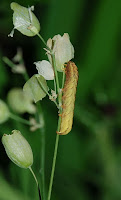 One of the simplest ways of supporting butterflies and moths around your plot is to grow plants which act as nectar sources or as food plants for larvae.
One of the simplest ways of supporting butterflies and moths around your plot is to grow plants which act as nectar sources or as food plants for larvae.Nectar:
Aubretia - Easy to grow, has spring flowers.
Buddleia - The number one favourite - many varieties
Honesty - Flowers in spring. Can be invasive.
Ice Plant - For late summer and autumn.
Sedum - spectable is supposed to be the best.
Inula - A large daisy-like golden-yellow flower.
Lavender - Especially liked by Small and Large Whites.
Michaelmas Daisy - For the end of autumn when most flowers have finished.
Mint - Very invasive, many different varieties. Small butterflies like it as much as Marjoram.
Perennial Wallflower - Easy to propagate from cuttings. Flowers throughout the year.
Runner Beans - (yes really) Especially attractive to Brimstones.
Red Valerian - Easy to grow, can be invasive. Flowers from spring to the end of autumn!
Scabious - Many different species. Do not collect plants/seeds from the wild.
Verbena bonariensis - Flowers all season until the first frosts.
Hebe - Attractive to butterflies Joe Pye weed (Eupatorium maculatum 'Atropurpureum' ) Attractive to Butterflies
Larval Food Plants:
Alder Buckthorn - For Brimstones
Garlic Mustard - For Orange Tips
Holly and Ivy - For Holly Blues. The Holly (for the first generation; both male and female plants are now known to be ok, but the larva are easily found on berries on the female plants). Ivy (for the second generation); some variegated species bear more flowers (which the larvae feed on at night) and are less invasive.
Nasturtium - For Large and Small Whites. The plants can be decimated, so make sure you grow plenty in clumps.
Nettles - If you can stand a patch in full sun. Cut part down in April to produce fresh new growth and encourage Small Tortoiseshells and Peacocks to lay eggs on the plants in May/June.
Ragwort - For Cinnabar Moth caterpillars. The plant is poisonous.
Groundsel - For Cinnabar Moth caterpillars.
Honesty - Caterpillar food plant for Orange Tip
Sweet Rocket - Caterpillar food and nectar plant for Orange Tip
With special thanks to David Plews for his contributions to this page.






No comments:
Post a Comment